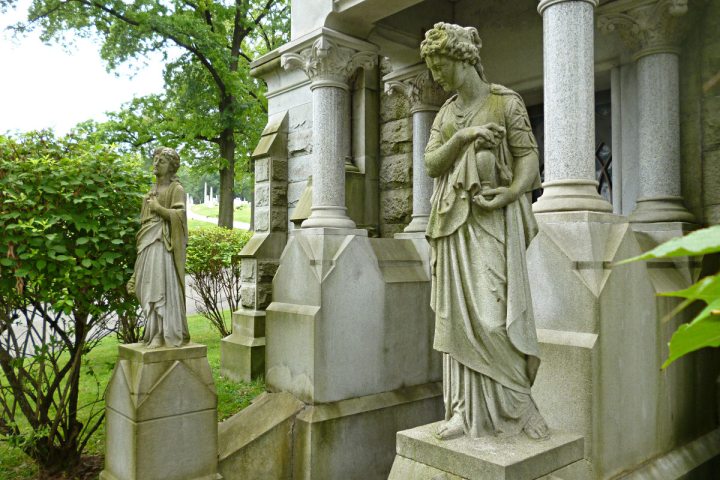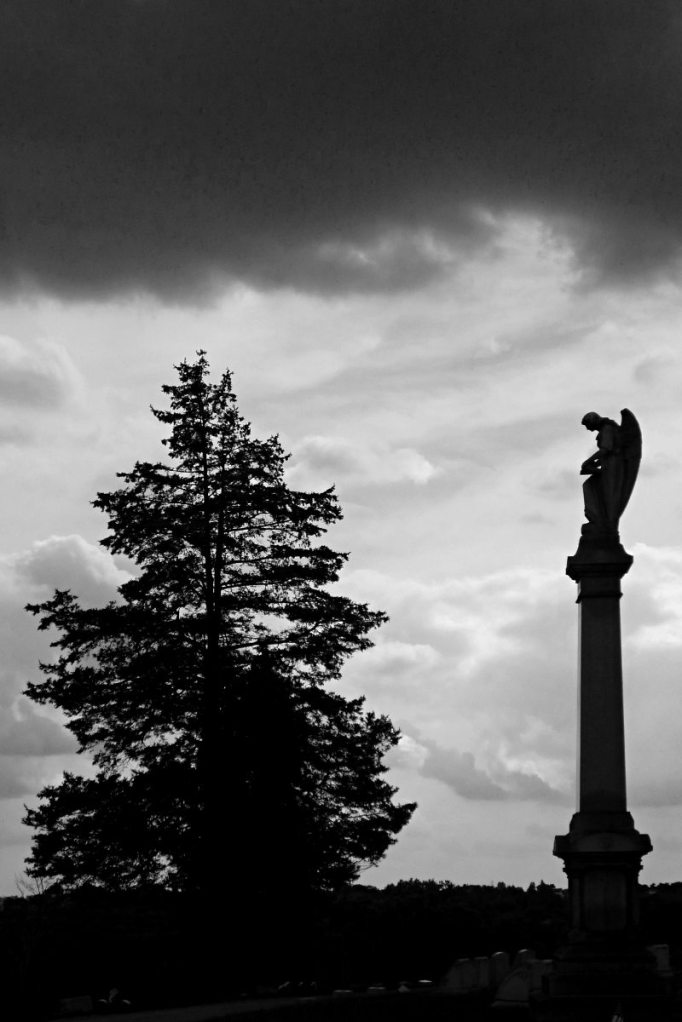The Wilkins family took the word “mausoleum” quite seriously and attempted a scale model of the Mausoleum at Halicarnassus, which is probably the inspiration for more constructions in Pittsburgh than any other classical edifice.
-
Wilkins Mausoleum, Homewood Cemetery
-
Stained Glass in the Shields Mausoleum, Homewood Cemetery
Mr. Shields decided to take his favorite pinup girl with him to the grave. A stout wooden beam apparently holding up the ceiling of the mausoleum stands in the way of the view of this window; Father Pitt has therefore stitched this picture together from two separate pictures, and the seam is obvious. But the window is unusual enough that we can tolerate a substandard photograph.
-
Joseph Horne Monument, Allegheny Cemetery
Joseph Hone, the department-store baron, certainly had enough money for a mausoleum, but chose to be remembered by this beautiful monument instead. Because the relief is worth examining, old Pa Pitt has given you this picture in a larger size than usual: click on it to load the picture in your browser, then magnify it to full size.
-
Stained Glass in the Wittmer Mausoleum, Allegheny Cemetery
-
Mourner on the Braun Mausoleum, Carrick
-
McCune Mausoleum, Allegheny Cemetery
This extraordinarily tasteful Renaissance octagon (built in 1925) is so unusual that Father Pitt suspects it may be based on a historical model. He would be delighted if one of his readers could find the original and point it out to him. John Robison McCune III was a banker, head of one of the biggest banks in the city (Union National, which after being devoured by Integra and National City is now part of PNC).
The interior is as elegant as the exterior. McCune took nothing of his private life with him to the grave—no Masonic or even religious symbols. His mausoleum, including the exceptionally fine window, is dedicated solely to beauty.
-
The Egyptian Style in Allegheny Cemetery
In Pittsburgh the Egyptian style of architecture was briefly popular in the early twentieth century, almost always in association with death. The mausoleums in Egyptian style seem usually to belong to Masons, who trace their lodge and rituals back to the days of the Pharaohs, implausible as that may seem to Egyptologists. Some integrate Christian, Masonic, and Egyptian symbols rather uncomfortably.
We begin with the Hartley-Given mausoleum (1913).
This is a simple and straightforward interpretation of an Egyptian tomb, and we can see the elements that, in the Allegheny Cemetery, almost invariably mark the Egyptianness of the style: the sloping sides and the lotus columns. Over the entrance we usually find a winged scarab entwined by serpents—which Father Pitt believes is a Masonic symbol; perhaps a Mason will correct him if he is wrong.
Next, the Lockhart mausoleum (1903):
 Here is another typical Egyptian-tomb design, again with the requisite Egyptian signifiers; but in this one the porch projects from the structure instead of being inset.
Here is another typical Egyptian-tomb design, again with the requisite Egyptian signifiers; but in this one the porch projects from the structure instead of being inset.The Sproal-Splane mausoleum (1917) is another variation on the same theme, with all the same elements and another inset porch:
Inside is a window that seems like a riot of symbols uneasily coexisting:
(The inscription around the cross and crown reads “IN HOC SIGNO VINCES.”)
All these are in reasonably good taste. But there is one Egyptian mausoleum that proudly flaunts its kitsch, one of the most extraordinary memorials in a cemetery full of extraordinary memorials:
 All the same elements are there, but the Winter mausoleum (1930)—whose colossal scale is hard to convey in a photograph—adds its own unique accessories. John Russell Pope, the famous beaux-arts architect, designed this mausoleum for banker Emil Winter—but “designed” is not really the right word here. The Woolworth mausoleum in Woodlawn, the Bronx, is nearly identical; Winter apparently saw it and told Pope “I want that,” and Pope gave it to him.
All the same elements are there, but the Winter mausoleum (1930)—whose colossal scale is hard to convey in a photograph—adds its own unique accessories. John Russell Pope, the famous beaux-arts architect, designed this mausoleum for banker Emil Winter—but “designed” is not really the right word here. The Woolworth mausoleum in Woodlawn, the Bronx, is nearly identical; Winter apparently saw it and told Pope “I want that,” and Pope gave it to him. Mr. Winter’s amazing sphinxes bear an expression that old Pa Pitt can only describe as “snooty.”
Mr. Winter’s amazing sphinxes bear an expression that old Pa Pitt can only describe as “snooty.” The bronze door depicts Mr. Winter himself, large as life and in full Pharaonic regalia, about to set off for his journey into the afterlife. Even this is identical to the bronze door of the Woolworth mausoleum, except for the substitution of Mr. Winter’s face.
The bronze door depicts Mr. Winter himself, large as life and in full Pharaonic regalia, about to set off for his journey into the afterlife. Even this is identical to the bronze door of the Woolworth mausoleum, except for the substitution of Mr. Winter’s face. Inside is a stained-glass window that reminds Father Pitt of cheap illustrated Sunday-school handouts, showing Mr. Winter properly enthroned. (It was devilishly hard to get a picture of this window, because the front doors are actually backed by a mesh screen. This was the best old Pa Pitt could do.)
Inside is a stained-glass window that reminds Father Pitt of cheap illustrated Sunday-school handouts, showing Mr. Winter properly enthroned. (It was devilishly hard to get a picture of this window, because the front doors are actually backed by a mesh screen. This was the best old Pa Pitt could do.)Finally, as a coda to our little Egyptian tour, the Huhn monument is actually a pyramid.
 This is a pyramid of a curiously specific type: it is (if Father Pitt’s architectural history is correct, and he loves to be corrected when he is wrong) a Roman interpretation of the Egyptian pyramid, with proportions more like those of the Pyramid of Cestius along the Appian Way than like those of a true Egyptian pyramid. This also is a Mason’s tomb; if you enlarge the picture (by clicking on it), you can see the Masonic symbols at the base.
This is a pyramid of a curiously specific type: it is (if Father Pitt’s architectural history is correct, and he loves to be corrected when he is wrong) a Roman interpretation of the Egyptian pyramid, with proportions more like those of the Pyramid of Cestius along the Appian Way than like those of a true Egyptian pyramid. This also is a Mason’s tomb; if you enlarge the picture (by clicking on it), you can see the Masonic symbols at the base. -
J. B. Ford Mausoleum, Allegheny Cemetery
J. B. Ford, founder of Pittsburgh Plate Glass, has one of the grandest mausoleums in the Allegheny Cemetery, which is saying a good deal. The town of Ford City is named for him. It would be an interesting study to survey the Allegheny Cemetery and find how many of its residents have towns named after them; one might well find that there are more people with towns named after them here than in any other cemetery in the country.
-
Carrick from the South Side Cemetery
In many city neighborhoods you’ll find a cemetery or two much older than the neighborhood itself. Cemeteries were established in the countryside outside the city; the city grew to engulf them, but they often remain little oases of rural stillness in the urban bustle. The South Side Cemetery has graves going back well before the Civil War, when Carrick was farmland and wilderness, and the hilly location gives us spectacular views in all directions. The contrast between the dense and cluttered urban neighborhood and the calm peace of the cemetery seems as though it ought to be a metaphor for something.
-
An Angel in Carrick



























